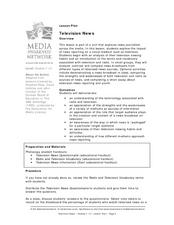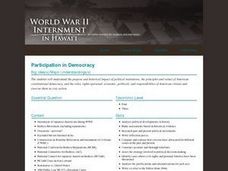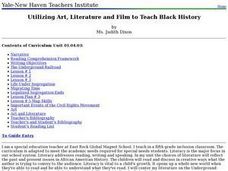Curated OER
Television News
Different media sources portray news in a variety of ways. In groups of three, learners look at different news sources, bringing in all the findings the next day. Three handouts help scholars compare sources, define specific terms used...
Curated OER
Feudalism and the Magna Carta
Students compare the Magna Carta and the Bill of Rights. In this historical comparison lesson, students examine primary sources of three significant historical documents. Students create a chart in a compare and contrast format, then...
Curated OER
Now You See Me, Now You Don't
Bioluminescence fascinates most upper elementary scientists. Display images of different glowing deep-sea organisms and discuss their environment. Young biologists then experiment with images and different colors of filtered light. In...
Curated OER
Documenting Texas Women’s History through Photographs
Middle schoolers explore women’s history. In this women’s studies lesson, students will examine seven photographs that depict prominent female figures from Texas’s history. Middle schoolers will engage in a discussion of the photographs...
Curated OER
The Walking Purchase of 1737
Students review the main points of the Walking Purchase of 1737. In groups, they describe how the Iroquois, Minisink, and Delaware Indians felt about the purchase and compare and contrast the different views. They write and perform a...
Curated OER
Trade Impasse
High schoolers examine the concept of free trade. They watch a video clip about this topic and write an essay comparing the opinions of the guests on the show. They research a country and role-play their decisions in international trade.
Curated OER
Political Traditions
Students compare and contrast the political institutions in Greece, Rome, and the United States. In groups, they take this information to determine the influences on James Madison when organizing the republic. They develop a chart and...
Curated OER
Children's Rights/Child Labor - Photos & Posters as Instruments of Change
Students research the use of students for labor around the globe. Using magazine pictures, they create a poster showing the various conditions they are subject to. They compare and contrast the differences in regions and evaluate the...
Curated OER
The Institutions of Government: The Judiciary
Students explain the difference between tribal, state and federal sovereignty. Using the internet, they read Supreme Court cases that focus on Native American law. They compare and contrast the view of the case from the Native...
Curated OER
What is an Organism?
Sixth graders take a pre-test and summarize teacher's discussion of cells, tissues, organs in their notebooks. They read selections on organisms in their textbook and perform a dissection of a chicken drumstick with the thigh attached....
Curated OER
Children's Media and Censorship
Students examine the point of censorship when dealing with Students. They explore essays by Stephen King.
Curated OER
Develop Your Own Interpretation
High schoolers use pieces of Andy Warhol's art to write critiques. Using different points of view, they answer discussion questions and share them with the class. They also interpret the art from a historian and artist point of view. ...
Curated OER
Internet Versus Daily Newspapers
Seventh graders address a series of questions based on Bloom's Taxonomy. Students find a position to be formulated and defended, specifically the Internet newspaper or the traditional daily newspaper. Students create a five card...
Curated OER
Photojournalism: A Record of War
Pupils explore who has photographed war and why. They examine Mathew Brady's process for photgraphing the Civil War. Students investigate how photographic equipment has changed and improved through time. They analyze primary source war...
Curated OER
The Colors of Chemistry
Students investigate the acidity and alkalinity of common household products in an experiment. They use red cabbage juice and litmus paper to show the difference between strong acids and bases as they work with vinegar, dish washing...
Curated OER
Participating in Democracy
Students analyze film clips in class. In this democracy activity, students identify the differences between civil liberties, democracy and freedom. Students view a video regarding Japanese internment and answer study questions as well as...
Curated OER
Utilizing Art, Literature and Film to Teach Black History
Fifth graders are introduced to different aspects of African-American history through literature, art, and films. As a class, they are read a story about the Underground Railroad, identify the main characters and put the events into...
Curated OER
The World's Most Practiced Religions
Students examine the five major religions of the world. In groups, they identify the belief system of each and research their history. They discover the various holidays and traditions of the religions. They present their findings to...
Curated OER
See That Sound?
Students study sonar and will explain the concept of it and its major components. For this design lesson students build a low-cost sonar system.
Curated OER
Sources of Information
Students review information from a previous instructional activity about JFK and his assassination. As a class, they identify sources they believe historians use and describe the difference between a primary and secondary source. In...





















